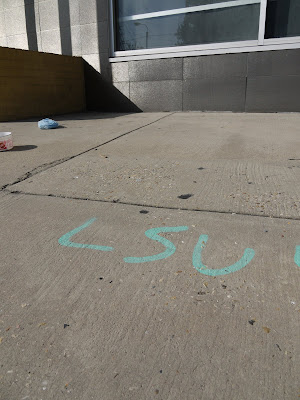So how was the proposed University Medical Center (UMC) project here in New Orleans allowed to devastate a neighborhood so irresponsibly?
Remember this? It's a provision in the Programmatic Agreement (PA) that was meant to govern site preparation for the LSU/VA hospital project. And it was meant to ensure proper treatment of the many historic resources in the site of the proposed UMC.
It was designed to ensure that the historic neighborhood inside the LSU Footprint was not destroyed unnecessarily, to make certain that a business plan and full funding was in place for the proposed UMC.
The provision clearly didn't serve its function. The UMC still has no business plan. And it still doesn't have adequate financing lined up to complete the full first phase of the hospital as envisioned. Meanwhile, the LSU Footprint has been largely razed.
On June 24, 2010, the State of Louisiana's Facility Planning and Control department sent a letter to the Advisory Council on Historic Preservation, a federal entity, claiming that the state had met the requirement. But you'll see, as you read through the following summary excerpt, that even on that date, the state had in fact not secured a full funding stream. It only had $800 million on hand out of the $1.2 billion necessary:
Nonetheless, Jerry Jones signed off on the letter - one that claims there is a business plan.
This summer, one year later, even Governor Jindal has admitted publicly that there is still no business plan for the UMC. His words and actions in response to the Tucker-Kennedy-Vitter alternative plan made that quite clear.
As early as July 26, 2010, Sandra Stokes with the Foundation for Historical Louisiana countered the letter, laying out a list of specific concerns with the state's representations. The letter closed with this prophetic language:
On July 19, 2010, however, the Advisory Council had already seemingly signed off on the weak sauce justification by the state:
That second sentence could be relevant - I wonder if the Advisory Council is fully aware of the effects on historic properties like McDonogh No. 11 School and the houses theoretically about to move off the LSU Footprint.
In August of 2010, Mr. Reid Nelson at the Advisory Council subsequently responded to the Stokes letter with language that the Advisory Council should, given the events of the past year, regret deeply:
The Advisory Council on Historic Preservation was given a chance to demand a responsible outcome, and it has very clearly failed. Dozens of historic buildings and a large part of a National Register Historic District were destroyed because of the lack of adequate oversight.
The Advisory Council's position is made even more embarrassing by the fact that a July 25, 2010 Times-Picayune article made it quite clear that the UMC project, per multiple sources, had neither adequate financing nor a completed business plan:
How do things stand today, more than a year later?
There is no business plan - no really, there is no business plan.
177 demolitions have been completed.
The project does not have adequate financing in place - and the UMC Board has decided not to try for HUD mortgage insurance to guarantee bonds....something Fred Cerise effectively said was necessary just about one year ago.
Not only did the federal government proactively participate in the funding and planning that permitted this destructive project, it also failed to protect the city and neighborhood when it had an express opportunity to do so, even as all the warning bells were ringing.











No comments:
Post a Comment